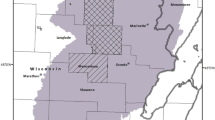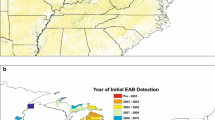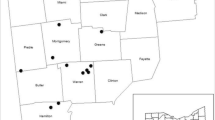Abstract
Invasive species are widely recognized as altering species and community dynamics, but their impacts on biogeochemical cycling and ecosystem processes are less understood. The emerald ash borer (Agrilus planipennis Fairmaire) is a phloem feeding beetle that was inadvertently introduced to the US in the 1990s and relies solely on ash trees (Fraxinus spp.) to complete its life cycle. Ash trees have a wide geographic distribution and are an important component of many different forest types in the US. The larval feeding behavior of the emerald ash borer (EAB) effectively girdles the tree’s phloem tissue resulting in tree mortality in as little as 2 years and stand mortality in as little as 5 years. Using the forest inventory and analysis database, we found that forest lands in the lower 48 states hold approximately 8.7 billion ash trees and saplings, which represent ~2.5 % of the aboveground forest carbon mass. Furthermore, we measured tree growth in 7 EAB impacted and 5 non-EAB impacted temperate forests in the Midwestern United States to quantify the impacts of EAB induced tree mortality on tree growth. We hypothesized that the initial C lost would be partly compensated for by the enhanced non-ash tree growth in EAB-impacted regions relative to non-EAB impacted regions. The EAB disturbance enhanced growth of non-ash trees in the EAB impacted region relative to the non-EAB impacted region. Results also indicate that in EAB impacted areas, growth of trees from the genera Acer and Ulmus responded most positively. Finally, we quantified annual biometric net primary productivity of the EAB impacted forests and compared these quantities to modeled growth of these forests in the absence of EAB and found that large scale ash tree mortality has reduced short term regional forest productivity. The loss of ash biometric net primary productivity is, in part compensated by enhanced growth of non-ash species. As expected, EAB disturbance severity was greater in forests with higher basal areas of ash. This study illustrates the ecosystem and regional scale impacts of invasive pest-induced disturbance on biogeochemical cycling and forest species composition.





Similar content being viewed by others
References
Anagnostakis SL (1987) Chestnut blight: the classical problem of an introduced pathogen. Mycologia 79:23–37
Ayres MP, Lombardero MJ (2000) Assessing the consequences of global change for forest disturbance from herbivores and pathogens. Sci Total Environ 262:263–286
Baker TR, Affum-Baffoe K, Burslem DFRP, Swaine MD (2002) Phenological differences in tree water use and the timing of tropical forest inventories: conclusions from patterns of fry season diameter change. For Ecol Manag 171(3):261–274
Bauer LS, Haack RA, Miller DL, Petrice TR, Liu H (2003a) Emerald ash borer life cycle. In: Mastro V, Reardon R (eds) Abstracts of emerald ash borer research and technology development meeting. Forest Health Technology Enterprise Team. USDA FHTET-2004-02
Bauer LS, Miller DL, Taylor RAJ, Haack RA (2003b) Flight potential of the emerald ash borer. In: Mastro V, Reardon R (eds) Abstracts of emerald ash borer research and technology development meeting. Forest Health Technology Enterprise Team. USDA FHTET-2004-02
Bauer LS, Gould J, Liu H, Ulyshen M, Duan J, Sadof C, Ziegler A, Fraser I, Lelito J (2010) Update on emerald ash borer biological control research in the US In: Proceedings, emerald ash borer research and technology development meeting; 2009 October 21–22; Pittsburgh, pp 53–54
Bell DT (1997) Eighteen years of change in an Illinois streamside deciduous forest. J Torrey Bot Soc 124(2):174–188
Birdsey RA (1992) Carbon storage and accumulation in United States forest ecosystems. General technical report WO-59. USDA Forest Service, Washington
Birdsey RA, Heath LS (1995) Carbon changes in US forests. In: Joyce LA (ed) Productivity of America’s Forest Ecosystems. General Technical Report RM-GTR-271. USDA Forest Service, Rocky Mountain Forest and Range Experiment Station, Fort Collins, pp 56–70
Birdsey RA, Schreuder HT (1992) An overview of forest inventory and analysis estimation procedures in the Eastern United States with an emphasis on the components of change. General Technical Report RM-214. USDA Forest Service, Rocky Mountain Forest and Range Experiment Station, Fort Collins
Bolin B (1977) Changes of land biota and their importance for the carbon cycle. Science 196:613–615
Brasier CM (1991) Ophiostoma novo-ulmi sp. nov., causative agent of the current Dutch elm disease pandemics. Mycopathologia 115:151–161
Brown SL, Schroeder PE (1999) Spatial patterns of aboveground production and mortality of woody biomass for eastern US forests. Ecol Appl 9:968–980
Bruhn D, Leverenz JW, Saxe H (2000) Effects of tree size and temperature on relative growth rate and its components of Fagus sylvatica seedlings exposed to two partial pressures of atmospheric CO2. N Phytol 146:415–425
Cappaert D, McCullough DG, Poland TM, Siegert NW (2005) Emerald ash borer in North America: a research and regulatory challenge. Am Entomol 51:152–165
Chambers JQ, Fisher JI, Zeng H, Chapman EL, Baker DB, Hurtt GC (2007) Hurricane Katrina’s carbon footprint on US gulf coast forests. Science 318:1107
Chapin FS, Zavaleta ES, Eviner VT, Naylor RL, Vitousek PM, Reynolds HL, Hooper DU, Lavorel S, Sala OE, Hobbie SE, Mack MC, Diaz S (2000) Consequences of changing biodiversity. Nature 405:234–242
Churkina G, Running SW (1998) Contrasting climatic controls on the estimated productivity of global terrestrial biomes. Ecosystems 1:206–215
Clark KL, Skowronski N, Hom J (2010) Invasive insects impact forest carbon dynamics. Global Change Biol 16:88–101
Condit R, Ashton P, Bunyavejchewin S, Dattaraja H, Davies S, Esufali S, Ewango C, Foster R, Gunatilleke I, Gunatilleke C, Hall P, Harms KE, Hart T, Hernandez C, Hubbell S, Itoh A, Kiratiprayoon S, Lafrankie J, de Lao SL, Makana JR, Noor MN, Kassim AR, Russo S, Sukumar R, Samper C, Suresh HS, Tan S, Thomas S, Valencia R, Vallejo M, Villa G, Zillio T (2006) The importance of demographic niches to tree diversity. Science 313:98–101
Curtis PS, Hanson PJ, Bolstad P, Barford C, Randolph JC, Schmid HP, Wilson KB (2002) Biometric and eddy-covariance based estimates of annual carbon storage in five eastern North American deciduous forests. Agric For Meteorol 113:3–19
Dale VH, Joyce LA, McNulty S, Neilson RP, Ayers MP, Flannigan MD, Hanson PJ, Irland LC, Lugo AE, Peterson CJ, Simberloff D, Swanson FJ, Stocks BJ, Wotton BW (2001) Climate change and forest disturbance. Bioscience 51:723–734
Ehrenfeld JG (2010) Ecosystem consequences of biological invasions. Annu Rev Ecol Evol Syst 41:59–80
Ellsworth DS, Reich PB (1993) Canopy structure and vertical patterns of photosynthesis and related leaf traits in a deciduous forest. Oecologica 96:169–178
Fajvan MA, Wood JM (1996) Stand structure and development after gypsy moth defoliation in the Appalachian Plateau. For Ecol Manag 89:79–88
Flower CE, Knight KS, Gonzalez-Meler MA (2010) Using stable isotopes as a tool to investigate the impacts of EAB on tree physiology and EAB spread. In: Lanc D, Buck J, Binion D, Reardon R Mastro V (eds) Proceedings of the emerald ash borer research and technology development meeting, Pittsburgh, PA, 20–21 October 2009, FHTET-2010-01. USDA Forest Service Health Technology Enterprise Team, Morgantown, WV, pp 53–54
Fuester RW, Duan JJ, Wildonger J, Taylor PB (2010) Biological control of emerald ash borers: the role of indigenous North American parasitoids. In: Proceedings, Emerald ash borer research and technology development meeting; 2009 October 21–22; Pittsburgh, pp 88–90
Gandhi, KJK, Smith A, Long RP, Herms DA (2007) Patterns of emerald ash borer induced ash decline and mortality in the forests of southeastern Michigan. In: Mastro V, Lance D, Reardon R, Parra G (eds) Proceedings of the emerald ash borer and Asian longhorned beetle research and technology development meeting; 2006 October 29–November 2; Cincinnati, pp 26–27
Garnier E (1991) Resource capture, biomass allocation and growth in herbaceous plants. Trends Ecol Evol 6:126–131
Goodale CL, Apps MJ, Birdsey RA, Field CB, Heath LS, Houghton RA, Jenkins JC, Kohlmaier GH, Kurz W, Liu S, Nabuus G-J, Nilsson S, Shvidenko AZ (2002) Forest carbon sinks in the northern hemisphere. Ecol Appl 12:891–899
Gough CM, Vogel CS, Schmid HP, Curtis PS (2008) Controls on annual forest carbon storage: lessons from the past and predictions for the future. Bioscience 58(7):609–622
Gough CM, Flower CE, Vogel CS, Dragoni D, Curtis PS (2009) Whole-ecosystem labile carbon production in a north temperate forest. Agric For Meteorol 149(9):1531–1540
Haack RA, Jendek E, Liu H, Marchant KR, Petrice TR, Poland TM, Ye H (2002) The emerald ash borer: a new exotic pest in North America. N Mich Entomol Soc 47(3&4):1–5
Hancock JE, Arthur MA, Weathers KC, Lovett GM (2008) Carbon cycling along a gradient of beech bark disease impact in the Catskill Mountains, New York. Can J For Res 38:1267–1274
Hicke JA, Allen CD, Desai AR, Deitze MC, Hall RJ, Hogg EH, Kashian DM, Moore D, Raffa KF, Sturrock RN, Vogelmann J (2012) Effects of biotic disturbances on forest carbon cycling in the United States and Canada. Global Change Biol 18(1):7–34
Högberg MN, Högberg P (2002) Extramatrical ectomycorrhizial mycelium contributes one-third of microbial biomass and produces, together with associated roots, half the dissolved organic carbon in a forest soil. N Phytol 154:791–795
Högberg P, Nordgren A, Buchmann N, Taylor AFS, Ekblad A, Högberg MN, Nyberg G, Ottosson-Löfvenius M, Read DJ (2001) Large-scale forest girdling shows that current photosynthesis drives soil respiration. Nature 411:789–792
Jedlicka J, Vandermeer J, Aviles-Vazquez K, Barros O, Perfecto I (2004) Gypsy moth defoliation of oak trees and a positive response of red maple and black cherry: an example of indirect interaction. Am Midl Nat 152(2):231–236
Jenkins JC, Chojnacky DC, Heath LS, Birdsey RA (2003) National-scale biomass estimators for United States tree species. J For Sci 49(1):12–35
Karnosky DF (1979) Dutch elm disease: a review of the history, environmental implications, control, and research needs. Environ Conserv 6:311–322
Knight KS, Long RP, Rebbeck J, Smith A, Gandhi K, Herms DA (2008). How fast will trees die? A transition matrix model of ash decline in forest stands infested by emerald ash borer. In: Mastro V, Reardon R, Parra G (eds) Proceedings of the emerald ash borer research and technology development meeting; 2007 October 23–4; Pittsburgh. FHTET 2008–2007. Morgantown, WV: US Forest Service, Forest Health Technology Enterprise Team, pp 29–30
Korsgaard S (1986) An analysis of the potential for timber production under conservation management in the tropical rainforest of South East Asia. Interim project status report. The Research Council for Development Research, Copenhagen, p 48
Kurz WA, Dymond CC, Stinson G, Rampley GJ, Neilson ET, Carroll AL, Ebata T, Safranyik L (2008) Mountain pine beetle and forest carbon feedback to climate change. Nature 452:987–990
Lewis K, Thompson RD, Trummer L (2005) Growth response of spruce infected by Inonotus tomentosus in Alaska and interactions with spruce beetle. Can J For Res 35:1455–1463
McCullough DG, Katovich SA (2004) Pest alert: emerald ash borer. United States Forest Service, Northeastern Area. NA-PR-02-04
McCullough DG, Poland TM, Anulewicz AC, Lewis P, Molongoski J (2010) Evaluation of emamectin benzoate and neonicotinoid insecticides: two-year control of EAB? In: Lanc D, Buck J, Binion D, Reardon R Mastro V (eds) Proceedings of the emerald ash borer research and technology development meeting, Pittsburgh, PA, 20–21 October 2009, FHTET-2010-01. USDA Forest Service Health Technology Enterprise Team, Morgantown, WV, pp 68–70
Nave LE, Gough CM, Mauer KD, Bohrer G, Hardiman BS, Le Moine J, Munoz AB, Nadelhoffer KJ, Sparks JP, Strahm BD, Vogel CS, Curtis PS (2011) Disturbance and resilience of coupled carbon and nitrogen cycling in a north temperate forest. J Geophys Res 116:G04016. doi:10.1029/2011JG001758
Nicholas NS, Gregoire TG, Zedaker SM (1991) The reliability of tree crown position classification. Can J For Res-Rev Can de Res For 21:698–701
Ogren E, Sundin U (1996) Photosynthetic responses to variable light: a comparison of species from contrasting habitats. Oecologia 106:18–27
Oliver CD, Larson BC (1996) Forest stand dynamics, update edition. Wiley, New York
Pedersen BS, Howard JL (2004) The influence of canopy gaps on overstory tree and forest growth rates in a mature mixed-age, mixed-species forest. For Ecol Manag 196:351–366
Peltzer DA, Allen RB, Lovett GM, Whitehead D, Wardle DA (2010) Effects of biological invasions on forest carbon sequestration. Global Change Biol 16:732–746
Poland T, McCullough D (2006) Emerald ash borer invasion of the urban forest and the threat to North America’s ash resource. J For 104:118–124
Poulson TL, Platt WJ (1996) Replacement patterns of beech and sugar maple in Warren Woods. Mich Ecol 77(4):1234–1253
Prasad AM, Iverson LR, Peters MP, Bossenbroek JM, Matthews SN, Snydor TD, Schwartz MW (2010) Modeling the invasive emerald ash borer risk of spread using a spatially explicit cellular model. Landsc Ecol 25(3):353–369
Prescott C (2002) The influence of the forest canopy on nutrient cycling. Tree Physiol 22:1193–1200
Pugh SA, Liebhold AM, Morin RS (2011) Changes in ash tree demography associated with emerald ash borer invasion, indicated by regional forest inventory data from the Great Lakes States. Can J For Res 41:2165–2175
Raich JW, Schlesinger WH (1992) The global carbon dioxide flux in soil respiration and its relationship to vegetation and climate. Tellus Ser B 44:81–99
Reich PB, Grigal DF, Aber JD, Gower ST (1997) Nitrogen mineralization and productivity in 50 hardwood and conifer stands on diverse soils. Ecology 78(2):335–347
Safford LO (1973) Fertilization increases diameter growth of birch-beech-maple trees in New Hampshire. In: US Department of Agriculture, Forest Service, Research Note NE-182. Upper Darby, Northeastern Forest Experiment Station, p 4
Siegert NW, McCullough DG, Liebhold AM, Telewski FW (2007) Resurrected from the ashes: as historical reconstruction of emerald ash borer dynamics through dendrochronological analysis. In: Mastro V, Reardon R (eds) Proceedings of the emerald ash borer research and technology development meeting; 2006 October 29–November 2; Cincinnati. FHTET 2007-04. Morgantown, WV: US Forest Service, Forest Health Technology Enterprise Team, pp 18–19
Smith A (2006) Effects of community structure on forest susceptibility and response to the emerald ash borer invasion of the Huron River watershed in southeast Michigan. A Thesis pp 1–134
SYSTAT (2007) SYSTAT 12.0 for windows. SPSS, Chicago
US Forest Service (2007) Forest inventory and analysis national core field guide, volume 1: field data collection procedures for phase 2 plots, version 4.0. Available from http://www.fia.fs.fed.us/library/field-guides-methods-proc/ Accessed 15 Sept 2009
van Doorn NS, Battles JJ, Fahey TJ, Siccama TG, Schwarz PA (2011) Links between biomass and tree demography in a northern hardwood forest: a decade of stability and change in Hubbard Brook Valley, New Hampshire. Can J For Res 41:1369–1379
Veblen TT, Hadley KS, Reid MS, Rebertus AJ (1991) The response of subalpine forests to spruce beetle outbreak in Colorado. Ecology 72(1):213–231
Vogt K (1991) Carbon budgets of temperate forest ecosystems. Tree Physiol 9:69–86
Walters MB, Kruger EL, Reich PB (1993) Relative growth rate in relation to physiological and morphological traits for northern hardwood tree seedlings: species, light environment and ontogenetic considerations. Oecologia 96:219–231
Wang XY, Yang ZQ, Gould JR, Zhang YN, Liu GJ, Liu ES (2010) The biology and ecology of the emerald ash borer, Agrilus planipennis, in China. J Insect Sci 10:128
Williams CA, Collatz GJ, Masek J, Goward SN (2012) Carbon consequences of forest disturbance and recovery across the conterminous United States. Global Biogeochem Cycles 26, GB1005, doi:10.1029/2010GB003947
Zweifel R, Item H, Häsler R (2001) Link between diurnal stem radius changes and tree water relations. Tree Physiol 21:869–877
Zweifel R, Eugster W, Etzold S, Dobbertin M, Buchmann N, Häsler R (2010) Link between continuous stem radius changes and net ecosystem productivity of a subalpine Norway spruce forest in the Swiss Alps. N Phytol 187:819–830
Acknowledgments
The authors would like to thank B. Long for establishing the plots in 2005, T. Fox, K. Costilow, L. Long, and S. Smith for their field assistance and Clifford Shirek for his assistance with production of Fig. 1. This research was supported by the National Science Foundation Grant DGE-0549245, “Landscape Ecological and Anthropogenic Processes”, the University of Illinois at Chicago (Hadley grant and Provost Fellowship), and the USFS NRS. We are grateful to three anonymous referees for their valuable contributions to the improvement of this manuscript.
Author information
Authors and Affiliations
Corresponding author
Rights and permissions
About this article
Cite this article
Flower, C.E., Knight, K.S. & Gonzalez-Meler, M.A. Impacts of the emerald ash borer (Agrilus planipennis Fairmaire) induced ash (Fraxinus spp.) mortality on forest carbon cycling and successional dynamics in the eastern United States. Biol Invasions 15, 931–944 (2013). https://doi.org/10.1007/s10530-012-0341-7
Received:
Accepted:
Published:
Issue Date:
DOI: https://doi.org/10.1007/s10530-012-0341-7




